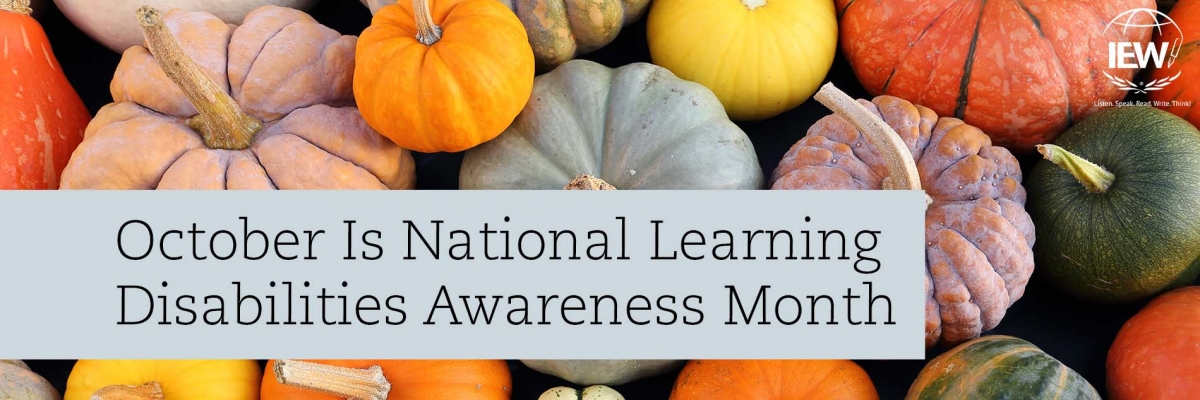
Happy fall! Some of us have already been enjoying cooler temperatures and colorful fall foliage. For others the show is just beginning. But October doesn’t just herald the fall; it is also the month during which our nation brings awareness to learning disabilities. Established by proclamation by Ronald Reagan in 1985, Proclamation 5385 launched a formal recognition and call to awareness of the learning difficulties that many face in America. Because Structure and Style is so effective for students affected by learning disabilities, we reached out to teachers and parents to hear their thoughts about how the Structure and Style method helped their students. A few of their responses, which appear below, we are sharing with you today.
The systematic, you-can’t-help-too-much modeling is in line with the Orton Gillingham methodology. This is the only system of writing that clearly defines the process and removes barriers. Plus, Mr. Pudewa is a great storyteller. That helps! ~ Heather
My ten-year-old has Asperger’s Syndrome and a diagnosed writing disability. I chose to start my son with All Things Fun and Fascinating as a gentle introduction to IEW’s program. My son is thriving with it. He likes the step-by-step instructions and the guided method. He thrives with learning a concept by receiving clear and detailed instructions on how to implement it. We are moving along at his pace, and I have seen remarkable improvement since we started the program. I am already researching which theme-based book to get for him next, with plans to do the Structure and Style for Students course when he is in sixth grade and more comfortable with the method. ~ Ruby
I have many students that come to me with dyslexia, Down Syndrome, and other special needs. IEW’s method has been successful with all of these students. IEW's systematic approach allows these students to learn a concept and put it to use. There is no guessing for them. They know exactly what to do, which allows them to relax and just apply what they have learned. Their anxiety levels are greatly reduced, and they feel successful. Students who feel successful are successful! ~ Joann
The systematic, sequential approach to teaching writing has been the key to my students’ successes. The EZ+1 method allows my students to work at their own pace while adding new skills regularly. IEW’s writing method is successful because it provides students with structure while teaching them style that allows them to grow as creative and unique people. ~ Mindy
For my ASD (autism spectrum disorder) son, Structure and Style broke down the needed steps to organize the information. This equipped him to be able to write about it. This was an essential component that was missed in other programs. ~ Christine
I am a Barton tutor, and IEW’s writing method follows the phrasing for who/what, did what, where/when, why, and how, which are practiced in Levels 3–10 of the Barton program for reading comprehension. From there it is easy to help students to build quality sentences with the Structure and Style method. My seventh grade student in public school told her parents, “This is how I learned to write.” ~ Beverly
My students are successful because it’s broken down into such easy steps. The checklists in particular have been very helpful. The new updated versions make it so a busy mom can still have her kids watch the instructional videos without her. ~ Stacie
My son has dyslexia and dysgraphia. Writing was difficult. We started IEW’s program in tenth grade. I loved the structure and sequence. It allowed him to learn at his pace. We did most things on a big whiteboard together. He eventually did it on his own! ~ Ligia
I am using SSS-1A with my daughter who has severe combined-type ADHD and moderate to severe dyslexia. I believe IEW’s method has been successful because it breaks down writing into smaller bite size pieces, and for now my daughter isn’t needing to focus on content and how to write … just the writing process itself. Self-created content will come later. I love that the videos engage her in ways I can’t, and she can pause the video until she is done with her writing and doesn’t feel rushed the way she would in a classroom. ~ Laura
Using IEW’s program with my special needs daughter has been a huge win for us. She has gone from a frustrated and struggling learner to a more confident and seemingly in-control-of-her-own-destiny student. She still gets a little frustrated sometimes, but that's part of the growth process. Mr. Pudewa's calm yet engaging presence throughout the courses is the key for my daughter. Excellent program! I'm glad I found it. ~ Jane
We are truly gratified to hear of so many students finding success with Structure and Style. As you move through the month of October, certainly enjoy the colorful leaves and crisp air, but also take some time to increase your knowledge about learning disabilities.
While we may never be able to fully eradicate learning disabilities, we have come a long way since 1985. As researchers, educators, neurologists, and scientists continue to uncover more about learning disabilities, perhaps someday we will find a way to overcome them. Until that day arrives, we need to remember that learning doesn’t always come easily and automatically for everyone. As educators, our job is to help our students succeed, one step at a time. Thankfully Structure and Style helps us to break those steps down into manageable ones that spark students’ success.
If you would like to learn more about how IEW can help you teach your students, check out our page dedicated to special needs, IEW.com/SPED. One of the links on that page will take you to a recording of the January 2021 online conference, Success in Teaching Writing: A Special Education Writing Conference, which you can watch for free.
